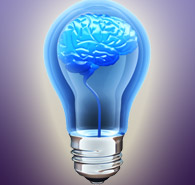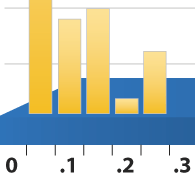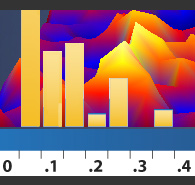Archive for the ‘Clinical Results’ Category
Monday, September 27th, 2010
 The following is a brief report on a recent case of recovery from addiction. This was one of the first addiction cases in which we utilized the extension of our software to cover the low frequency range down to 0.1 mHz (milliHertz). Essentially all of the training of this client took place within this range, i.e. with the exception of several Alpha-Theta sessions. The client has given permission for us to tell her story. She is of middle age now, and has been struggling with addiction to heroin and cocaine for the last fifteen years. When she had her first experience with heroin, she knew immediately that she would do anything to repeat it. The cocaine came later. Episodically, she experienced an overwhelming, compulsive drive to use “that blows everything else away.” She was unable to resist, and in these episodes nothing else mattered. With that lifestyle came going to the bad parts of town, and dealing with people one would rather avoid. “It pulls you into this dark place that makes you hate yourself. It is addiction at its worst.” The following is a brief report on a recent case of recovery from addiction. This was one of the first addiction cases in which we utilized the extension of our software to cover the low frequency range down to 0.1 mHz (milliHertz). Essentially all of the training of this client took place within this range, i.e. with the exception of several Alpha-Theta sessions. The client has given permission for us to tell her story. She is of middle age now, and has been struggling with addiction to heroin and cocaine for the last fifteen years. When she had her first experience with heroin, she knew immediately that she would do anything to repeat it. The cocaine came later. Episodically, she experienced an overwhelming, compulsive drive to use “that blows everything else away.” She was unable to resist, and in these episodes nothing else mattered. With that lifestyle came going to the bad parts of town, and dealing with people one would rather avoid. “It pulls you into this dark place that makes you hate yourself. It is addiction at its worst.”
Before beginning neurofeedback, she has participated in twenty-five rehabilitation treatments for her addiction over the last fifteen years, and has been through multiple incarcerations related to drug use. She was taking Suboxone, itself an opiate used to detox people from heroin. This helped to manage her heroin addiction and moderate her cravings.
(more…)
Posted in Clinical Results, Efficacy, Neurofeedback | No Comments »
Thursday, August 5th, 2010
 The Dysponesis Hypothesis The Dysponesis Hypothesis
We are always casting about for better ways to frame the work that we do in order to make it comprehensible to other professionals and lay persons. Sometime it helps to dip into past history to see how others wrestled with the same issue. One notion that has threaded its way through is that of simple inefficiency in brain regulatory function, which naturally leads to the suggestion that our training improves regulatory effectiveness through promoting higher efficiency in the regulatory mechanisms. It’s a simple concept with a certain amount of face validity, and also offers the virtue of vagueness where we are still uncertain about the details. Another slightly different theme is that the brain sometimes works against itself, that its efforts to right the ship are sometimes counter-productive.
The term dysponesis encompasses a variety of dysfunctions in which the CNS operates counter to the desired end-result. In considering the possible utility of this term in modern parlance, I am going back to an article written by George Whatmore and Daniel Kohli back in 1968 (Behavioral Science, 13(2), 102-124, (1968)), and reprinted as a book chapter in the text Mind/Body Integration (Erik Peper, Sonia Ancoli, and Michelle Quinn, editors), which was first published in 1979. The authors were two physicians in private practice.
(more…)
Posted in Application of Neurofeedback, Biofeedback, Clinical, Clinical Results, Clinical Symptoms, Disregulation, Neurofeedback, Research, Scientific | 4 Comments »
Wednesday, March 10th, 2010
 The first convincing evidence for EEG feedback efficacy in the management of pathophysiology was with regard to generalized seizures. The early work by Sterman, Lubar, as well as the subsequent follow-up by others, therefore remains a crucial point of reference for the various feedback techniques that have built upon the early protocol of SMR reinforcement combined the theta-band and high-beta band inhibition. Remarkably, the essential features of the early approach have been retained in the various evolutionary pathways that have emanated from the early work. This essential similarity has perhaps obscured other aspects of the training approach that have changed substantially over time, the significance of which may not have been fully appreciated except in reflection. In this newsletter we consider some of these changes and their implications generally, as well as for seizure management in particular. The first convincing evidence for EEG feedback efficacy in the management of pathophysiology was with regard to generalized seizures. The early work by Sterman, Lubar, as well as the subsequent follow-up by others, therefore remains a crucial point of reference for the various feedback techniques that have built upon the early protocol of SMR reinforcement combined the theta-band and high-beta band inhibition. Remarkably, the essential features of the early approach have been retained in the various evolutionary pathways that have emanated from the early work. This essential similarity has perhaps obscured other aspects of the training approach that have changed substantially over time, the significance of which may not have been fully appreciated except in reflection. In this newsletter we consider some of these changes and their implications generally, as well as for seizure management in particular.
The common thread in most modern neurofeedback approaches is the combination of a reinforcement strategy on one EEG frequency or another and an inhibit strategy based on detection of excursions into dysregulation. Some issues relating to the inhibit side have been relegated entirely to the software, thus removing them from ready visibility. Artifact detection and the division of labor between that and the conventional inhibits is a case in point. Specific targeting strategies typically remain to the discretion of the practitioner, as for example with respect to thresholding, placement, and frequency band selection. The general thrust over time has been to broaden the “field of view” of this EEG-based disregulation detector, mainly with respect to the frequencies being targeted, but sometimes also in terms of placement. Multi-channel instruments allow independent choice of placement for the reward and the inhibit strategies. Fortuitously, the various inhibit strategies being actively used—-though differing significantly from each other—-have not been wrapped up in much controversy.
(more…)
Posted in Application of Neurofeedback, Clinical Methods, Clinical Results, Efficacy, Neurofeedback | No Comments »
Thursday, February 19th, 2009
 We have just experienced a remarkably quick recovery from PTSD symptoms in a Vietnam veteran. The case is illustrative of the more rapid pace of recovery that is achievable with the latest neurofeedback techniques that encompass the infra-low range of EEG frequencies. The veteran has had a forty-year history of PTSD, and was rescued from homelessness by the Salvation Army here in Los Angeles. He came to our offices for intensive neurofeedback training through the auspices of the Salvation Army. In exchange for our providing services at no cost, the veteran has allowed us to make his case history available for the benefit of other clinicians. We have just experienced a remarkably quick recovery from PTSD symptoms in a Vietnam veteran. The case is illustrative of the more rapid pace of recovery that is achievable with the latest neurofeedback techniques that encompass the infra-low range of EEG frequencies. The veteran has had a forty-year history of PTSD, and was rescued from homelessness by the Salvation Army here in Los Angeles. He came to our offices for intensive neurofeedback training through the auspices of the Salvation Army. In exchange for our providing services at no cost, the veteran has allowed us to make his case history available for the benefit of other clinicians.
For scientific purposes, the veteran has agreed to undergo pre-post quantitative EEG analysis (courtesy of QMetrx) and SPECT imaging (courtesy of the Amen Clinics). As the training is still on-going, these pre-post comparisons are not yet available. However, we do have initial symptom-tracking data that already tell quite a story. Symptoms are assessed on the basis of self-report at typically three-session intervals. Severity is rated on a ten-point scale. Results for the first eighteen training sessions are shown in Figure 1. Overall symptom reduction reached 50% by session ten, and was more than 80% by session eighteen. The symptom list was broadly inclusive, and covered a number of areas not considered to be classically associated with PTSD. Eleven out of the twenty major symptoms were rated at zero by session 18. None were rated higher than 4 out of ten by session 18. The picture is one of broad improvement in self-regulatory capacity.
The picture is actually even more dramatic when data are segregated for the symptoms commonly associated with PTSD. These are shown in Figure 2. With regard to PTSD symptoms, overall improvement reached 50% within three sessions, and reached 93% in 18 sessions. Even more significantly, nightmares, flashbacks, suicidal thoughts, and binging and purging were all eliminated within three sessions. These were the most troublesome PTSD-related symptoms. The most persistent symptoms related to the quality of sleep. At the first QEEG session it became obvious that the veteran was suffering from sleep apnea. He was unable to stay awake for the QEEG assessment. This was a problem during the early neurofeedback sessions as well. By session 18, he was getting through entire alpha-theta sessions without falling asleep. Other persistent symptoms relate to motor function and mobility. Currently the veteran remains confined to a wheelchair. The improvement in hypertension is not entirely attributable to neurofeedback: as a result of the training, the veteran was motivated to be more consistent in taking his blood pressure medication. (more…)
Tags: PTSD, Siegfried Othmer
Posted in Application of Neurofeedback, Clinical Results, Efficacy, Neurofeedback, Protocols, PTSD, Veterans | 2 Comments »
Monday, November 24th, 2008

The following newsletter is now mainly of historical interest. Discussed here is the design of the first-generation Cygnet, which was intended for operation within the conventional EEG spectrum. There was no recognition yet of the need to cover the extremely low frequency region. The follow-on design, which became available in 2012, was optimized for operation across the entire band, including in particular the infra-low frequency region extending down to 0.1mHz. (Siegfried Othmer, 1/6/2015)
The recent newsletter on Infra-low Frequency Training raised a number of issues within our readership and within the larger neurofeedback community. The principal issues are addressed in the following.
First of all there is the issue of how we detect infra-low frequency activity with an amplifier that “cuts off” at 0.08 Hz. The Cygnet system incorporates a single stage of high-pass filtering into its design. We did so to provide more stable and more graceful operation of the system in its most common applications. Little did we know that down the line our most common applications would extend well into the frequency range that we were cutting off with our filter.
A single stage of filtering yields a gentle filter function, with an attenuation of a factor of ten for a factor of ten in frequency. This is best shown in a graph that uses logarithmic scales, particularly since we are now covering such a broad range in frequency. The amplifier transfer characteristic is shown in Figure 1. At a frequency of 0.008 Hz, for example, our system gain is a factor of ten down from the cutoff frequency of 0.08. Whether or not this presents a real problem is not a matter of the signal level, but rather of the signal-to-noise ratio. At low frequencies, we tend to refer to this as drift rather than noise, but there is no real distinction implied here. (more…)
Posted in Application of Neurofeedback, Clinical Results, Neurofeedback, Research | 3 Comments »
|
|
Subscribe to Email Newsletter
The EEG Info Newsletter circulates via email at least once a month. A variety of topics related to the Neurofeedback / EEG Biofeedback field are covered in over 200 articles.
|
 The following is a brief report on a recent case of recovery from addiction. This was one of the first addiction cases in which we utilized the extension of our software to cover the low frequency range down to 0.1 mHz (milliHertz). Essentially all of the training of this client took place within this range, i.e. with the exception of several Alpha-Theta sessions. The client has given permission for us to tell her story. She is of middle age now, and has been struggling with addiction to heroin and cocaine for the last fifteen years. When she had her first experience with heroin, she knew immediately that she would do anything to repeat it. The cocaine came later. Episodically, she experienced an overwhelming, compulsive drive to use “that blows everything else away.” She was unable to resist, and in these episodes nothing else mattered. With that lifestyle came going to the bad parts of town, and dealing with people one would rather avoid. “It pulls you into this dark place that makes you hate yourself. It is addiction at its worst.”
The following is a brief report on a recent case of recovery from addiction. This was one of the first addiction cases in which we utilized the extension of our software to cover the low frequency range down to 0.1 mHz (milliHertz). Essentially all of the training of this client took place within this range, i.e. with the exception of several Alpha-Theta sessions. The client has given permission for us to tell her story. She is of middle age now, and has been struggling with addiction to heroin and cocaine for the last fifteen years. When she had her first experience with heroin, she knew immediately that she would do anything to repeat it. The cocaine came later. Episodically, she experienced an overwhelming, compulsive drive to use “that blows everything else away.” She was unable to resist, and in these episodes nothing else mattered. With that lifestyle came going to the bad parts of town, and dealing with people one would rather avoid. “It pulls you into this dark place that makes you hate yourself. It is addiction at its worst.”

 The first convincing evidence for EEG feedback efficacy in the management of pathophysiology was with regard to generalized seizures. The early work by Sterman, Lubar, as well as the subsequent follow-up by others, therefore remains a crucial point of reference for the various feedback techniques that have built upon the early protocol of SMR reinforcement combined the theta-band and high-beta band inhibition. Remarkably, the essential features of the early approach have been retained in the various evolutionary pathways that have emanated from the early work. This essential similarity has perhaps obscured other aspects of the training approach that have changed substantially over time, the significance of which may not have been fully appreciated except in reflection. In this newsletter we consider some of these changes and their implications generally, as well as for seizure management in particular.
The first convincing evidence for EEG feedback efficacy in the management of pathophysiology was with regard to generalized seizures. The early work by Sterman, Lubar, as well as the subsequent follow-up by others, therefore remains a crucial point of reference for the various feedback techniques that have built upon the early protocol of SMR reinforcement combined the theta-band and high-beta band inhibition. Remarkably, the essential features of the early approach have been retained in the various evolutionary pathways that have emanated from the early work. This essential similarity has perhaps obscured other aspects of the training approach that have changed substantially over time, the significance of which may not have been fully appreciated except in reflection. In this newsletter we consider some of these changes and their implications generally, as well as for seizure management in particular. We have just experienced a remarkably quick recovery from PTSD symptoms in a Vietnam veteran. The case is illustrative of the more rapid pace of recovery that is achievable with the latest neurofeedback techniques that encompass the
We have just experienced a remarkably quick recovery from PTSD symptoms in a Vietnam veteran. The case is illustrative of the more rapid pace of recovery that is achievable with the latest neurofeedback techniques that encompass the 